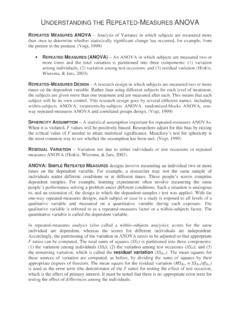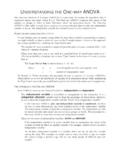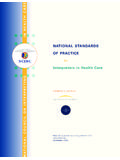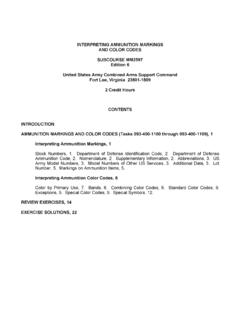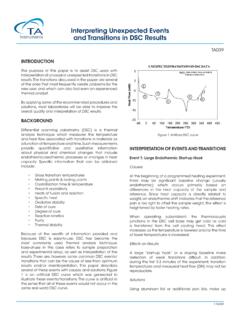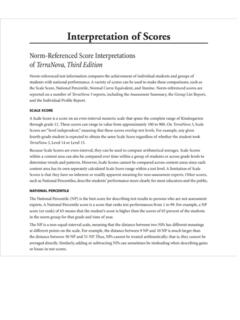Transcription of INTERPRETING THE ONE WAY ANALYSIS OF …
1 INTERPRETING THE ONE-WAY ANALYSIS OF VARIANCE (ANOVA) As with other parametric statistics, we begin the one-way ANOVA with a test of the underlying assumptions. Our first assumption is the assumption of independence. Recall that this assumption is assessed through an examination of the design of the study. That is, we confirm that the K groups/levels are independent of each other. We must also test the assumption of normality for the K levels of the independent variable. To test the assumption of normality, we can use the Shapiro-Wilks test, which is commonly used by statisticians, and is typically tested at the a =.
2 001 level of significance. The Shapiro-Wilks Test is a statistical test of the hypothesis that sample data have been drawn from a normally distributed population. From this test, the Sig. (p) value is compared to the a priori alpha level (level of significance for the statistic) and a determination is made as to reject (p < a) or retain (p > a) the null hypothesis. As a general rule, we should use other measures of normality checking in conjunction with the Shapiro-Wilks test ( , standardized skewness).
3 For our example, we obtained the following results: Tests of *. *. *. *. GroupRed GroupBlue GroupGreen GroupYellow GroupGain is a lower bound of the true significance.*. Lilliefors Significance Correctiona. Given that p = .627 for the Red Group, p = .341 for the Blue Group, p = .643 for the Green Group, and p = .766 for the Yellow Group and using a = .001 we would conclude that each of the levels of the Independent Variable (Treatment Group) are normally distributed. Therefore, the assumption of normality has been met for this sample.
4 The first table from the ANOVA output, (DESCRIPTIVES) provides familiar descriptive statistics ( , Group Size, Mean, Standard Deviation) for the four color groups on the dependent variable that we requested (Gain Score) for our example. The second table from the ANOVA output, (TEST OF HOMOGENEITY OF VARIANCES) provides the Levene s Test to check the assumption that the variances of the four color groups are equal; , not significantly different. Notice that the Levene s test is not significant; F(3, 36) = , p = .235 at the.
5 05 alpha level for our example. Thus, the assumption of homogeneity of variance is met ( , not violated) for this sample. If the result had been significant ( , assumption not met), then we could use an adjusted F test such as the Welch statistic or the Brown-Forsythe statistic. If there are extreme violations to the assumption of normality and the assumption of homogeneity of variance, a nonparametric test such as Kruskal-Wallis could be used. INTERPRETING THE ONE-WAY ANOVA PAGE 2 The third table from the ANOVA output, (ANOVA) is the key table because it shows whether the overall F ratio for the ANOVA is significant.
6 Note that our F ratio ( ) is significant (p = .001) at the .05 alpha level. When reporting this finding we would write, for example, F(3, 36) = , p < .01. The F indicates that we are using an F test ( , ANOVA). The 3 and 36 are the two degrees of freedom values (df) for the between groups effect and the within-groups error, respectively. The is the obtained F ratio, and the p < .01 is the probability of obtaining that F ratio by chance alone. F tables also usually include the mean squares, which indicates the amount of variance (sums of squares) for that effect divided by the degrees of freedom for that effect.
7 We also should report the means and standard deviations so that our readers can see what groups were low and high. Remember, however, that if you have three or more groups (such as in our example) we will not know which specific pairs of means are significantly different, unless we do a post hoc test or an a priori comparison test. At this point we have rejected the null hypothesis that all four groups means are equal, since p < a. We conclude that at least one of the group means is significantly different from the others (or that at least two of the group means are significantly different from each other).
8 Beyond this conclusion we will need to conduct a post hoc follow-up test to determine which means differ from each other. Since we have a significant F, we will want to measure the strength of association (w2) between the independent variable and the dependent variable for our example. Note that the omega square (w2) is not a paired effect size. This will need to be calculated by hand SPSS does not provide omega square values. Using the following formula: WTWBMSSSMSKSS+--=)1(2w We find w2 = )14( +-- = .29 Which indicates that the independent variable (four color groups) accounts for approximately 29% of the variance in the dependent variable (gain score) for this sample.
9 The fourth table from the ANOVA output, (ROBUST TESTS OF EQUALITY OF MEANS) is considered when the assumption of homogeneity of variance has not been met. The adjusted F ratio and its applicable Sig. (p) value are provided. If the adjusted F ratio is found to be significant ( , p < a), we would reject the null hypothesis and conclude that at least one of the group means is significantly different from the others (or that at least two of the group means are significantly different from each other). Beyond this conclusion we will need to conduct a post hoc follow-up test.
10 The applicable post hoc ANALYSIS will have to take into account that the equal variance assumption has been violated ( , Games-Howell). Note when setting up the steps in our ANALYSIS it is common to select at least one adjusted F ratio as a just-in-case ( , at the onset of our ANALYSIS we do not know if the assumption has been met or violated). For this example, since the equal variance assumption has been met, we can ignore the information in this table. INTERPRETING THE ONE-WAY ANOVA PAGE 3 There are numerous post hoc (multiple comparisons) procedure tests available.


